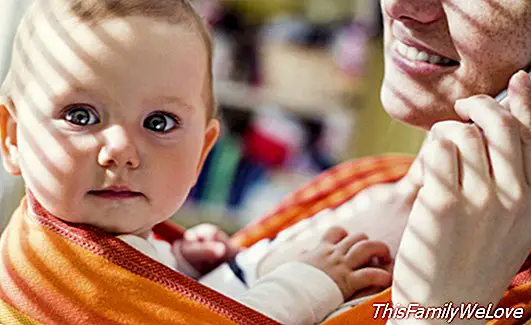10 benefits of ergonomic baby carriers
The ergonomic porting It is a transport system that offers a suitable posture for the baby and the adult, as well as constant contact between both. Being ergonomic respects the physiology and physiognomy of the two. Knowing a little more about the world of portage and ergonomic baby carriers and all their benefits, is essential for parents to experiment with this way of transporting their baby.
10 benefits and advantages of the use of ergonomic baby carriers
The main benefits of portage have to do both with the safety of the baby, and with the physical and emotional benefits for the child and his parents.
1. Sensation of security. After delivery, the baby recognizes the body of its mother as its habitat, feeling safe in contact with it. The ergonomic baby carrier gives you that security by feeling in contact with your mother's body.
2. Tranquility. When feeling safe, thanks to the body contact provided by the ergonomic baby carrier, the baby is calm. It does not activate its alarm systems, avoiding stress and devoting its energies to grow.
3. Improve the quality of sleep. When you are calm and feel safe, falling asleep is easier and, most importantly, you sleep soundly. Something essential since the brain organizes the experiences lived, precisely during the dream.
4. Greater physical well-being.On the maternal body, the baby's systems work optimally: they consume less oxygen, they manage energy expenditure more efficiently, they favor the expulsion of gases, a system of thermal self-regulation between carrier and porter is generated thanks to the ergonomic baby carriers.
5. Power secure attachment. Spending a lot of time in direct contact with the baby, using the baby carrier, allows you to intuitively learn your repertoire of acceptance and rejection signals. Thus, parents are better prepared to interpret them and respond quickly and efficiently.
6. Adaptation to the environment. The body contact provided by the ergonomic baby carrier accelerates the social performance of the baby, which develops links with its habitual caregivers, beyond the mother, with whom it has from the womb. In addition, from the lap he learns to differentiate threatening situations from those that are not, through the filtered information that he receives from the adult who brings him. Otherwise, the process slows down and the child remains alert until he learns to distinguish by himself.
7. Encourages breastfeeding. The contact between mother and child activates the same hormones that promote breastfeeding -oxitocin and prolactin-, favoring breastfeeding.
8. Protects the development of the back and hips. The baby must adapt to reach its standing function, typical of the human being. For that reason, the ventral and vertical posture that the baby adopts during the portage confers greater motor competence than lying on the cart.

9. It increases the autonomy and mobility of the carrier. By being part of their own body and having their hands free, the adult does not feel impeded when carrying out their daily activities with almost absolute normality and even go for a walk on the mountain with the baby carrier.
10. Respect and protect the back of the carrier. Contrary to what might seem, carrying the baby does not have to be detrimental to the postural health of the adult, since the baby carrier helps to distribute the weight balancedly and strengthens the muscles.
Sara Pérez
Advice: Laura García, founder of Pajarito Pinzón




